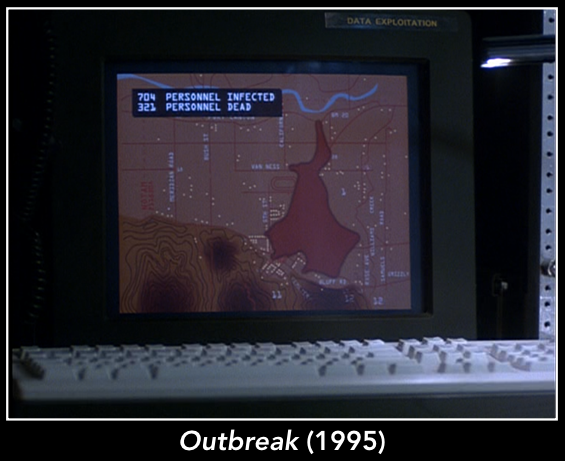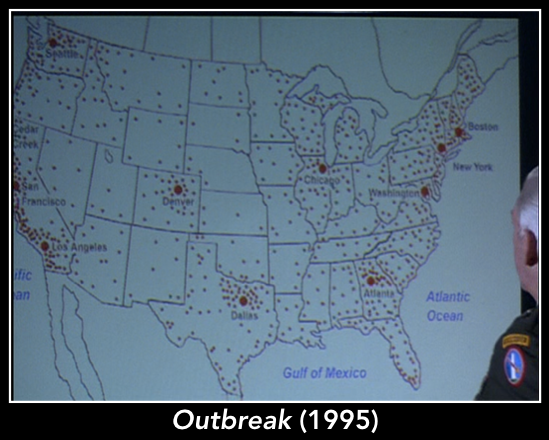Over the next few days (weeks?), I will post excerpts from my book Going Viral: Zombies, Viruses, and the End of the World. Taking a look at these fictional narratives before and even during an outbreak can help us see what to do and, more important, what not to do in real life. They can also remind us—even while this all feels so scary—that we have seen this before.


Another key trope of the outbreak narrative is the emphasis on making the invisible visible. Part of this fixation stems from the fear of the seemingly healthy carrier. One of the most terrifying elements of contagious disease is that of the carrier who does not appear infected, innocently or maliciously spreading the virus in his or her wake, and against whom one must defend one’s self.
Typhoid Mary may have been one of the main instigators of this archetype—spreading typhoid to those around her while appearing to be in perfect health—but there have been many more since her, both in real life and on-screen. While there is no carrier in Robert Wise’s Andromeda Strain (since the infected people are already dead) and the carrier is conspicuously sick in Black Death (Larry, 1992), starting with Outbreak (Petersen, 1995) and intensifying with Contagion, the seemingly healthy carrier plays a significant role, underscoring the threatening implications of the latency period.
The fear revolves around questions such as these: How can you protect yourself if you do not know from what (or from whom) you need protecting ? How can you protect yourself if you do not know who is infected? The longer the virus takes to show symptoms, the more people will inevitably be infected. This is why viruses with high mortality rates do not spread as much; the carriers die before they can infect others.
Autopsies are a way of seeing the unseen, cutting open the body to reveal the otherwise hidden wreckage wrought by the virus. In Black Death, Sara (a.k.a. patient zero) is autopsied, thus revealing the enormity of her illness. “Dear God, this is one node!” shouts one of the doctors slicing Sarah open, before running to put on two additional pairs of gloves.
In Outbreak, following Robby’s autopsy of Jimbo (Patrick Dempsey), she tells Sam that “it looked like a bomb went off ” inside him, that “all the organs were liquefied.”
After peeling the top of Beth’s scalp in Contagion, the medical examiner (David Lively) says, “Oh my god.” His assistant (Andrew White) asks if he should take a sample. The medical examiner replies, “I want you to move away from the table.” “Should I call someone?” the assistant asks. “Call everyone” is the dramatic reply.
In all three of these cases, we do not get to see what the doctors see, but we can surmise from their reactions that whatever lies inside these bodies is truly terrifying.
In response to the fear of the unseeable, outbreak narratives fetishize the close-up, the magnification, the zooming-in to expose that which would otherwise remain unseen.

For instance, the cover of Time magazine’s September 12, 1994, issue featured magnified microbes and the title “Revenge of the Killer Microbes.” On May 20, 1995, the cover of the Economist featured a skull within a petri dish and the headline “Disease Fights Back.” Outbreak narratives frequently call attention to their high-powered microscopes, emphasizing the extreme close-ups of these invisible viruses. Sometimes they even feature animated sequences that depict the virus “at work,” all with the aim of making the invisible contagions visible.

In this regard, outbreak narratives owe a significant stylistic debt to early public health films, which also struggled with how to visualize the invisible. A frequent trope of scientific documentaries and public health films is that microscopic view that allows us the pleasure of seeing what we cannot otherwise see. Kirsten Ostherr describes the “‘aesthetic of astonishment,’ in which pleasure revolve[s] around the fascination of seeing previously unimaginable views, including enlargements of bacteria and other revelations of the invisible, disease-carrying microbes that surround us.”
Ostherr traces how directors of global conspiracy films in the 1970s, educational AIDS videos in the 1980s, and viral outbreak narratives in the 1990s all used digital-imaging technologies to make visual the invisible (to the naked eye) nature of contagion with increasingly realistic-looking animation as well as shot after shot of maps, charts, and lists tracking the virus’s spread. Filmmakers, like doctors, are trying to visualize viruses in order to trace and follow the path of disease. Both need to see it in order to understand it and control it.

A pivotal scene in the original 1971 film Andromeda Strain features a dramatic zooming-in that results in the discovery of the elusive virus, depicting a mesh screen with a hole in it, the virus finally isolated and exposed in the tear. Screens are supposed to keep things out, but here is an example of a border that fails to protect, defenseless against the penetration and destruction performed by the virus. In a scene that might be painstakingly slow by today’s standards, each click of the microscope is dramatically emphasized as we come closer and closer to the virus and the torn screen.
There is a similar—albeit quicker—sequence in Outbreak and in the remake of Andromeda. The answer can be found if you know where and how to look and if you can look closely enough.
When the scientists finally isolate the Motaba virus, Sam, Casey, and Major Salt gather around a set of monitors, looking at the impact of the virus on healthy kidney cells. First we see the impact after one hour, then after several hours, and then after a couple more. For the grand finale, the microscope enlarges to allow us to see individual viral organisms, and then once more to see them closer, and then once again, and then one last time as Major Salt says, “Sirs, Mr. Motaba.”

The camera tracks even closer at this point onto the viral organism. Mr. Motaba shows up again, this time in a side-by-side comparison with the original virus from 1967, as General McClintock (Donald Sutherland) and General Ford (Morgan Freeman) discuss what should be done next, their lies about not recognizing the virus exposed in the parallels between the two viruses.
Public health films incorporate animated epidemiological maps to help visualize the spread of these invisible viruses. Hollywood films, too, use this kind of imagery—not only as a narrative tool or to make invisible global networks visible, delineating between “sanitary and unsanitary zones,” but also to add yet another dose of chilling realism to the spread of their epidemics.
Another part of this fixation stems from the fear that what you cannot see can kill you—and in terms of microbial threat, there is much that cannot be seen.
The invisible made visible is seen repeatedly in outbreak narratives, as it is a way to cognitively map the unknowable world system. Viewers see not only the virus but also the paths the virus takes, the actual transmission of the disease as it is traced, studied, and (possibly) neutralized.

These sequences heighten the suspense as we watch the disease spread.


In Contagion and Outbreak, we have shot after shot of charts visualizing the virus’s spread, reminders that globalization has only exacerbated the speed with which disease—and panic—can travel.

Most alarming, however, is that, despite this emphasis on making the invisible visible, technology has limits. Digital models may help identify the virus, but they cannot reveal the economic, political, and social forces behind it.


Recent Comments